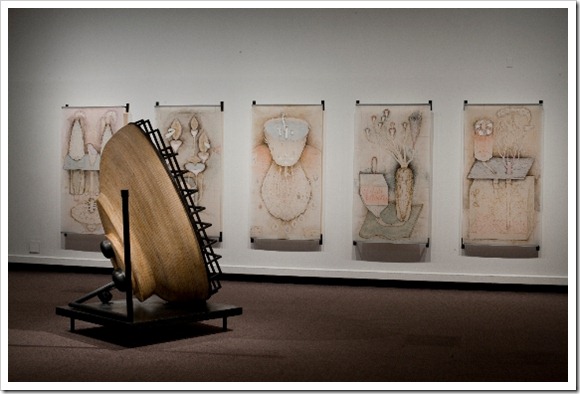Jan 17 2011
By Michael Davies-Venn
The topic remains complex and controversial, the technology innovative and promising, and the debate, on stem-cell research, continues unabated. And now, the subject is receiving the attention of a group not normally associated with scientific discoveries. University of Alberta printmaking professor, Sean Caulfield, along with U of A Health Law Institute research director and researcher, Tim Caulfield, have brought together a group of visual artists from Europe and North America to contribute to the stem-cell debate that often pits politicians, scientists, pundits and religious leaders against each other.
Lianne McTavish, U of A Art and Design professor, is the curator for Perceptions of Promise: Biotechnology, Society and Art, an exhibition on stem-cell research, organized by the Caulfield brothers, that formally opened at the Glenbow Museum, Calgary, Canada on Saturday.
Sean says the artists’ contributions, in combination with the work of biomedical scholars and scientists, helps advance the public debate on the stem-cell question. “Art has an important role to play in the discourse around biotechnology because it can offer unique articulations of the thoughtful, polarized and often emotionally charged responses the public has towards technology. This exhibition isn’t about taking sides in the stem-cell debate; it's about creating a place for reflection.”
And the space in the public consciousness is needed, says Tim, in order to create a middle ground on the debate. He says the biggest ethical issue during the debate, and the one that has caused stem-cell research to become what he describes as a “policy monster,” is the moral status of the embryo. Out of that portion has come extreme language and representations of science, he says.
“It has created a polarization of the depiction of stem-cell research. You have those who're against stem-cell research taking on extreme ideas and saying things like stem cells make for "reproductive cloning," "clone monsters,” "clone armies," and the idea that we're going to have half-human-half-animal creatures developed.
“And then on the pro side, those who support stem-cell research—those who want to garner public policy support for the field—that community, almost out of necessity, are using hyper representations of the promise of stem-cell research such as the idea that the technology will help us grow body parts in the future.
Of course, neither one of those extreme representations is true or accurate, said Tim. Nor, he says, are the visual representations in Perceptions of Promise: Biotechnology, Society and Art. Patrons who go to Glenbow Museum to see the multimedia exhibition, will have a lot to ponder—from a sculpture of human torso that is based on the imagery of CT medical scans and influenced by discussions of the use of stem cells collected from liposuction operations and used for facial creams, to drawings of one of the participating artist’s chromosomes. Sean hopes the diversity shown in the work offers the debate a different tone.
“I don’t want people to go to the exhibition and come out with an answer,” Sean said. “I want them to go to the exhibition and have the experience that moves them away from a polarized position to a position of more nuanced questioning. Art provides the space for contemplation, which other kinds of forms of communication can do but sometimes don’t do.”
That raises the questions of the place of art in scientific discoveries, particularly whether art can accurately represent science. It is a concern that Sean says is shared by some scientists he worked with. And the question is made even difficult when art is addressing an issue as controversial as stem cell.
“I sympathize with scientists in that regard. They get frustrated that the artists do not seem to make art that’s “scientifically accurate,” said Tim. “The reason why I sympathize with the scientists on this is because it’s very difficult; it’s not the job of the artist to represent science accurately. Their representations may be a reflection of the misperceptions that exist in society.”
He says the concern also seem to ignore the similarities between the two disciplines.
“Great science,” he says “is a creative process. It’s a process of discovery, imagination and pushing boundaries. And great art is the exact same thing. It’s a process of discovery, inspiration and creativity. And so they come at discovery differently and they use different tools, but they’re the same in many ways.”
The bigger issue then is not whether artists and scientists can collaborate; rather, it is finding out the contributions that artists can make in advancing science. And those contributions are immense, says Tim, as they would not only advance the work of scientists, they could help address increasing public concerns on the role of science in our daily lives.
“Science is becoming more complicated and powerful with each passing decade. And it seems like the controversy on stem-cell research is just the beginning.” Tim said. “We did a survey asking scientists about their views of the representation of science by pop-culture. And they said unequivocally that ‘yes, it has a huge role and has an impact on public perception, public policy, and even funding decisions.’ Research has consistently shown that pop culture representations, such as movies, news and fine arts, influences both public perception and can play an important role in the policy debate also.”
Sean says it will be prudent that artists are engaged and collaborate because he says every technology that we imposed on our society has a social dimension, whether it is stem cell or carbon capture.
“There's a social and cultural side to all these problems that our societies face and if we don't deal with them, we will end up facing serious problems,” Sean said.